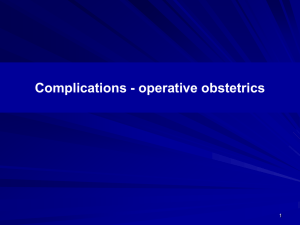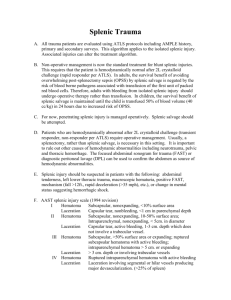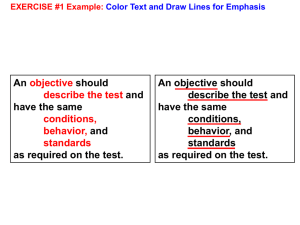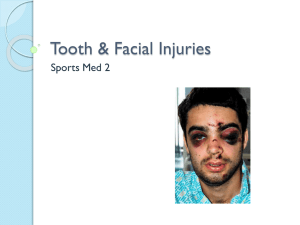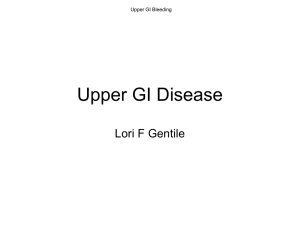File
advertisement
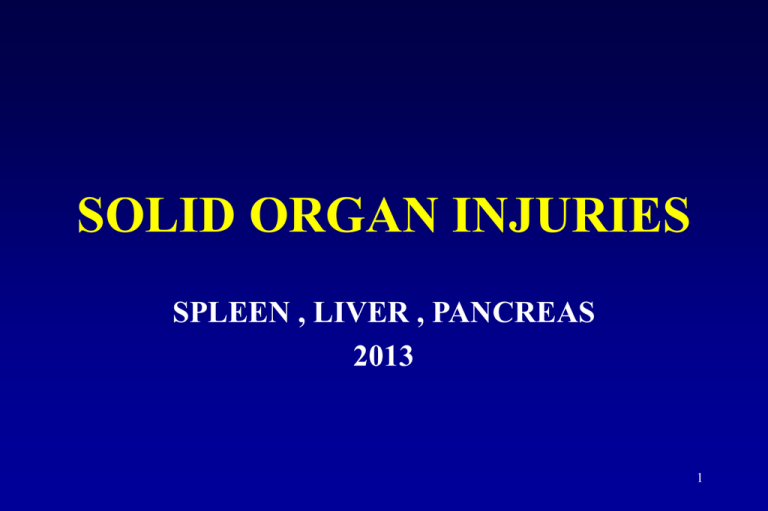
SOLID ORGAN INJURIES SPLEEN , LIVER , PANCREAS 2013 1 Abdominal Injuries • • • • • • 5 pillars Solid Organs: Bleed, shock Hollow Organs: Leak, peritonitis Retroperitoneum: pancreas, large vessels Urinary system Diaphragm 2 Mechanism of injuries • Blunt: • spleen, liver, and small bowel • Penetrating stab: • liver, small bowel, diaphragm, colon • Penetrating gun shot: • small bowel, liver, colon 3 Splenic Function • Immunologic filter • Primary remover of non-opsonized bacteria • Produces tuftsin and properdin • Properdin vital component of alternate pathway of complement activation • Immunoglobulin production 4 Splenic Anatomy • 100-250 grams • 200 cc/min blood flow • Splenic artery • 85%-extrasplenic bifurcation • 15%-extrasplenic trifurcation • Ligamentous attachments • stomach, kidney, diaphragm, colon 5 6 Diagnosis of Splenic Injury • Physical examination - poor sensitivity • Ultrasound - nonspecific • DPL-too sensitive, ? role in nonoperative management • CT-most common in hemodynamically stable pts • Laparoscopy-has not found a universal role 7 AAST SPLEEN INJURY SCALE (1994 REVISION) Grade Injury Description I Hematoma Subcapsular, nonexpanding, < 1 0% surface area Laceration Capsular tear, nonbleeding, < 1 cm parenchymal depth II Hematoma Subcapsular, nonexpanding, 10-50% surface area; intraparenchymal, nonexpanding, < 5 cm in diameter Laceration Capsular tear, active bleeding; 1-3 cm parenchymal depth which does not involve a trabecular vessel III Hematoma Subcapsular, > 50% surface area or expanding; ruptured subcapsular hematoma with active bleeding; intraparenchymal hematoma > 5 cm or expanding Laceration > 3 cm parenchymal depth or'involving trabecular vessels IV Hematoma Ruptured intraparenchymal hematoma with active bleeding Laceration Laceration involving segmental or hilar vessels producing major devaculadzation (> 25% of spleen) V Laceration Completely shattered spleen VI Vascular Hilar vascular injury which devascularizes spleen 8 Management of Splenic Injuries Factors Influencing Decision • • • • • • Age of patient- >55yo splenectomy better Success of non-operative management- 68-83% Risk of missed injury Risk of OPSI-0.026-1.0% over lifetime Risk of blood transfusion-0.014% per unit Risk of nontherapeutic laparotomy-0.01-6.0% 9 Non-Operative Management • • • • • • Proper patient selection Bed rest 2-3 days Serial physical exams, Hcts x 24-48 hours Follow-up CT scan at 3-5 days Overall hospitalization 5-10 days Severe injuries-3 months no contact sports 10 Non-operative management • Embolisation • Trans-arterial catheter aorta splenic artery • Partial or total splenic embolization • Splenic immunocompetence is preserved after splenic artery angio-embolisation 11 Operative Management • Midline incision, pack, examine abdomen • Systematic splenic mobilization • Splenorrhaphy- Cautery, surgicell, pledgetted sutures, mesh wrapping • Splenectomy- life threatening bleeding • Autotransplantation-experimental • Vaccination-Pneumococcus, H. influenza, N. meningitidis 12 13 14 Complications • Pneumonia most common • Subphrenic Abscess 3-13% • Recurrent bleeding - up to 45 days • 1% re-operative rate (for haematoma, or abscess drainage for example) • Acute gastric distention- kids usually • Thrombocytosis (very high platelets) 15 OPSI • • • • • • Nausea, vomiting, confusion, sepsis Mortality 50-70% Vaccine provides 60% protection Best timing of vaccine unknown Proper counseling a must Sensitive to malaria 16 HEPATIC INJURIES • • • • • ANATOMY INJURY CLASSIFICATION INITIAL PATIENT MANAGEMENT OPERATIVE TECHNIQUES SPECIAL TOPICS • JUXTAHEPATIC VENOUS INJURIES • SUBCAPSULAR / INTRAHEPATIC HEMATOMAS • EXTRAHEPATIC BILIARY TREE INJURIES • COMPLICATIONS • Most commonly injured in stab wounds and blunt injuries • Present as bleeding with hemodynamic instability 17 ANATOMY • LIGAMENTOUS ATTACHMENTS • TRIANGULAR • CORONARY • FALCIFORM • COUINAUD CLASSIFICATION OF LOBAR / SEGMENTAL DIVISIONS 18 LIVER INJURY SCALE (1994 REVISION) Grade Injury Description I Hematoma Laceration Subcapsular, nonexpanding, < 1 0 cm surface area Capsular tear, nonbleeding, < 1 cm parenchymal depth II Hematoma Subcapsular, nonexpanding, 10-50% surface area: intraparenchymal nonexpanding< 1 0 in diameter Capsular tear, active bleeding; 1-3 cm parenchymal depth, < 1 0 cm in length Laceration III Hematoma Laceration Subcapsular, > 50% surface area or expanding; ruptured subcapsular hematoma with active bleeding; intraparenchymal hematoma > 10 cm or expanding > 3 cm parenchymal depth IV Hematoma Laceration Ruptured intraparenchymal hematoma with active bleeding Parenchymal disruption involving 25-75% of hepatic lobe or 1-3 Couinaud's segments within a single lobe V Laceration Parenchymal disruption involving > 75% of hepatic lobe or > 3 Couinaud's segments within a single lobe Juxtahepatic venous injuries (i.e., retrohepatic vena cava/central major hepatic veins) Vascular VI Vascular Hepatic avulsion 19 20 DIAGNOSIS OF LIVER INJURY • • • • • ATLS primary / secondary surveys Peritoneal signs - exploration Hemodynamic instability - US or DPL Stable – CT scan with contrast (embolization) Non-operative management : hemodynamic stability, no other suspected injuries, alert patient*, ICU monitoring, accessible for re-examination, minimal transfusions 21 LIVER -Penetrating Wounds • STAB WOUNDS • • • • LOCAL WOUND EXPLORATION ULTRASOUND DPL ? LAPAROSCOPY • GUNSHOT WOUNDS • EXPLORE • ? ROLE FOR ULTRASONOGRAPHY • ? ROLE FOR LAPAROSCOPY 22 OPERATIVE TECHNIQUES • MANUAL COMPRESSION • EXPOSURE(INCISION + LIGAMENTS) • PRINGLE MANEUVER (32-75 MINUTES) • Portal vein; hepatic artery: block inflow of blood; find source of bleeding • TOPICAL HEMOSTATIC AGENTS • BOVIE / ARGON BEAM COAGULATOR • FIBRIN GLUE 23 24 OPERATIVE TECHNIQUES • Tractotomy / individual vessel and duct ligation • Omental packing • Resectional debridement • Absorbable mesh wrapping 25 26 OPERATIVE TECHNIQUES • Drainage (grade III or better) • Laparotomy pad packing - remove before 3 days if possible • *Deep sutures • *Hepatic artery ligation • *Anatomic lobectomy *avoid if possible 27 28 29 OPERATIVE TECHNIQUES • HEAT CONSERVATION • BEGINS WITH INITIAL PATIENT CONTACT • LIMIT HEMORRHAGE • SPEED / EFFICIENCY COUNTS • EQUATES TO PROMPT DECISION-MAKING • DAMAGE CONTROL SURGERY: quick, manage bleeding and contamination; continue resus in ICU • PREVENT TRIAD OF ACIDOSIS, COAGULOPATHY AND HYPOTHERMIA 30 (affects clotting mechanism) Control of Transhepatic Penetrating Wound 31 Juxtahepatic Venous Injury • Early recognition • Big (chest) incisions (laparotomy and thoracotomy) • Atrial-caval shunt or caval balloon shunt • Direct attack with or without hepatic vascular isolation • Packing alone 32 Atrial-Caval Shunt 33 Subcapsular Hepatic Hematomas During non-operative treatment , operate for: • On-going hemorrhage • Progressive expansion by ct scan • Signs of infection • Deteriorating transaminase measurements Intra-operative, if not expanding: • Leave alone in stable patients 34 Extrahepatic Biliary Tract Injury • Rare: 3-5% of all abdominal trauma • Gallbladder (most common) • cholecystectomy • CBD > RHD> LHD • <50% circumference - repair with or without Ttube; drain • >50% circumference - duct enterostomy; drain 35 36 COMPLICATIONS • Recurrent bleeding - 2% to 7% • Fever - 65% to 75%, grade 3 or more • Abscess - 2% to 10% (increased by shock, transfusion, colon injury) • Biloma / biliary fistula - 5% to 28% • Hemobilia - extremely rare; 1/3 have jaundice, upper GI bleed, right upper quadrant pain • Arterial portal venous fistula 37 Damage Control Considerations • • • • • • • Deep suturing Packing Omental packing Drains Antibiotics Atrial-caval shunts CT scan / non-operative management 38 PANCREATIC INJURY • RETRO-PERITONEAL ORGAN • PENETRATING INJURY – IS THE DUCT INTACT ? • BLUNT INJURY – TRANSECTION OF GLAND OVER THE VERTEBRAL COLUMN 39 PANCREATIC INJURY • • • • • DIAGNOSIS DIFFICULT HIGH INDEX OF SUSPICION CLINICAL EXAMINATION NOT HELPFUL U/S, CT SCAN IF STABLE SERUM AMYLASE (increased? Duct intact? >>) • do ERCP 40 Diaphragmatic injury • • • • • Traumatic rupture (blunt trauma) More common on left side (85%) Tear posterolateral from hiatus Herniation of stomach, colon, spleen into chest Penetrating injury usually a small hole, on either side 41 Diaphragmatic injury • Diagnosis: clinical difficult • Bowel sounds in chest on auscultation • CXR: high diaphragm on left side, or diaphragm invisible • Confirmation by passing a nasogastric tube, which can be seen in stomach in chest • Chronic: contrast studies (Ba meal or enema) 42 Diaphragmatic injury • Laparoscopy (or thoracoscopy) for diagnosis • Repair: surgical, via laparotomy (or thoracotomy), or endoscopic technique • Pitfall: PPV (positive pressure ventilation) reduced the abdominal organs from chest 43 Questions? 44

